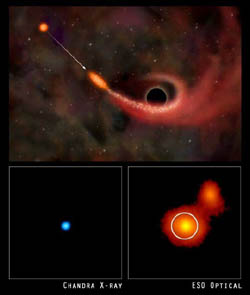Giant Black Hole Rips Apart Unlucky Star In Cosmic Reality Show
 |
Illustration of a black hole destroying a star in the galaxy RXJ1242-11
(Illustration: NASA/CXC/M. Weiss; X-ray: NASA/CXC/MPE/S. Komossa et al.; Optical: ESO/MPE/S. Komossa) |
Thanks to two orbiting X-ray observatories, astronomers have the first strong evidence of a supermassive black hole ripping apart a star and consuming a portion of it.
The event, captured by NASA's Chandra and ESA's XMM-Newton X-ray Observatories, had long been predicted by theory, but never confirmed.
Astronomers believe a doomed star came too close to a giant black hole after being thrown off course by a close encounter with another star. As it neared the enormous gravity of the black hole, the star was stretched by tidal forces until it was torn apart. This discovery provides crucial information about how these black holes grow and affect surrounding stars and gas.
"Stars can survive being stretched a small amount, as they are in binary star systems, but this star was stretched beyond its breaking point," said Stefanie Komossa of the Max Planck Institute for Extraterrestrial Physics (MPE) in Germany, leader of the international team of researchers. "This unlucky star just wandered into the wrong neighborhood."
While other observations have hinted stars are destroyed by black holes (events known as "stellar tidal disruptions"), these new results are the first strong evidence. Evidence already exists for supermassive black holes in many galaxies, but looking for tidal disruptions represents a completely independent way to search for black holes. Observations like these are urgently needed to determine how quickly black holes can grow by swallowing neighboring stars.
In the early 1990's the German Roentgen Satellite (ROSAT) detected a new x-ray
source in the direction of the galaxy RXJ1242-11. At the time, no one
knew the cause of this X-ray brightening. Recent observations with
Chandra and XMM-Newton confirmed that the X-rays were coming from the
center of the galaxy RXJ1242-11. The nature of the subsequent dimming
of the X-rays led astronomers to consider that the X-rays were coming
from gas, heated to millions of degrees Celsius, from the destroyed
star being swallowed by the black hole. The energy liberated in the
process was equivalent the energy released in a supernova.
Other dramatic flares have been seen from galaxies, but this is the first studied with the high-spatial resolution of Chandra and the high-spectral resolution of XMM-Newton. Both instruments made a critical advance. Chandra showed the RXJ1242-11 event occurred in the center of a galaxy, where the black hole lurks. The XMM-Newton spectrum revealed the fingerprints expected for the surroundings of a black hole, ruling out other possible astronomical explanations.
"Now, with all the data in hand, we have the smoking gun proof that this spectacular event has occurred," said coauthor Guenther Hasinger, also of MPE.
The black hole in the center of RXJ1242-11 is estimated to have a mass of about 100 million times Earth's sun. By contrast, the destroyed star probably had a mass about equal to the sun, making it a lopsided battle of gravity. "This is the ultimate David versus Goliath battle, but here David loses," said Hasinger.
The astronomers estimated about one percent of the star's mass was
ultimately consumed, or accreted, by the black hole. This small amount
is consistent with predictions that the momentum and energy of the accretion process will cause most of the destroyed star's gas to be flung away from the black hole.
The force that disrupted the star in RXJ1242-11 is an extreme example of the tidal force caused by differences in gravity acting on the front and back of an object. The tidal force from the moon causes tides in Earth's oceans. A tidal force from Jupiter pulled Comet Shoemaker-Levy apart, before it plunged into the giant planet.
The chance that a stellar tidal disruption will happen in a typical galaxy are low, about one in 10,000 annually. If it happened at the center of the Milky Way Galaxy, 25,000 light-years from Earth, the resulting X-ray outburst would be about 50,000 times brighter than the brightest X-ray source in our galaxy, beside the sun, but it would not pose a threat to Earth.
Additional Links
 Visit the XMM-Newton Learning Center. (http://heasarc.gsfc.nasa.gov/docs/xmm_lc/) Visit the XMM-Newton Learning Center. (http://heasarc.gsfc.nasa.gov/docs/xmm_lc/)
 Visit the Chandra site. (http://chandra.harvard.edu/) Visit the Chandra site. (http://chandra.harvard.edu/)
 Read more about Chandra. (http://chandra.nasa.gov/) Read more about Chandra. (http://chandra.nasa.gov/)
| 